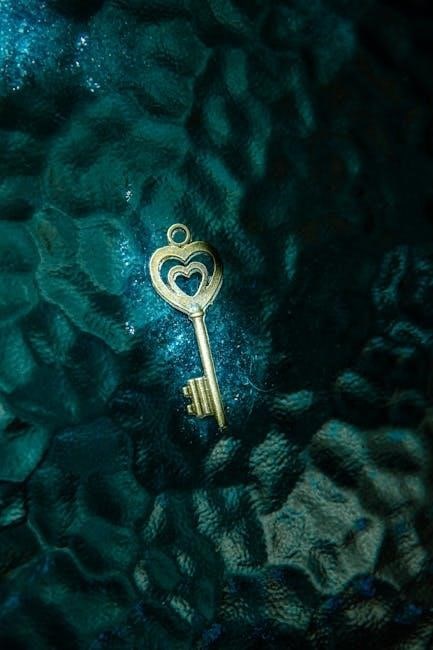Discover the fundamental concepts of ions through this comprehensive worksheet․ Explore how ions form, their charges, and roles in chemistry․ Ideal for students seeking a deep understanding of ionic structures and their significance in chemical reactions․ The answer key provides clear solutions to exercises, ensuring mastery of ion identification, formation, and naming․ This resource is perfect for both classroom use and self-study, offering a structured approach to learning about ions and their properties․
1․1 What Are Ions?
Ions are atoms or groups of atoms that have gained or lost electrons, resulting in a net positive or negative charge․ Positively charged ions are called cations, while negatively charged ions are anions․ Ions form when atoms gain or lose electrons to achieve a stable electron configuration․ For example, sodium atoms lose an electron to become Na⁺ cations, and chlorine atoms gain an electron to become Cl⁻ anions․ This process is fundamental in chemistry, enabling the formation of ionic compounds․ Understanding ions is crucial for understanding chemical bonding, reactions, and the properties of matter․
1․2 Importance of Understanding Ions in Chemistry
Understanding ions is essential in chemistry as they are fundamental to chemical bonding and reactions․ Ions determine the properties of ionic compounds, such as solubility and conductivity․ They play a critical role in forming salts, acids, and bases, which are vital in everyday products like food, medicine, and cleaning agents․ For instance, sodium (Na⁺) and chloride (Cl⁻) ions combine to form table salt (NaCl)․ Additionally, ions are key to biological processes, such as nerve signaling and muscle contraction․ Grasping ion behavior enhances problem-solving skills in chemistry and provides insights into the natural world, making it a cornerstone of chemical education․
Formation of Ions
Ions form when atoms gain or lose electrons to achieve stability․ This process results in positively or negatively charged particles, essential for understanding chemical bonding and reactions․
2․1 How Ions Are Formed from Neutral Atoms
Ions form when neutral atoms gain or lose electrons to achieve a stable electron configuration․ Metals typically lose electrons, becoming positively charged cations, while nonmetals gain electrons, forming negatively charged anions․ For example, sodium loses an electron to become Na⁺, and chlorine gains an electron to become Cl⁻․ This process stabilizes the atom’s outermost energy level, often mirroring the electron structure of noble gases․ Understanding this fundamental process is crucial for identifying ions and their charges in various chemical compounds and reactions․
2․2 Gaining and Losing Electrons
Gaining and losing electrons are key processes in ion formation․ Metals typically lose electrons to form positively charged ions (cations), while nonmetals gain electrons to form negatively charged ions (anions)․ For example, sodium (Na) loses an electron to become Na⁺, and chlorine (Cl) gains an electron to become Cl⁻․ This electron transfer stabilizes the atom’s electron configuration, often mimicking noble gas structures․ The process is driven by the atom’s desire to achieve a full outer energy level, ensuring chemical stability․ Understanding this mechanism is essential for identifying and predicting ion formation in various elements․

2․3 Polyatomic Ions and Their Formation
Polyatomic ions are groups of atoms bonded together that carry a collective charge․ They form through covalent bonding, where atoms share electrons to achieve stability․ For example, sulfate (SO₄²⁻) and carbonate (CO₃²⁻) are common polyatomic anions․ These ions often involve central atoms bonded to oxygen or other elements․ Their formation is crucial in creating ionic compounds like salts and minerals․ Polyatomic ions can be positively or negatively charged, such as ammonium (NH₄⁺)․ Understanding their structures and charges is essential for predicting their behavior in chemical reactions and compounds․ They are a key focus in worksheets for mastering ionic chemistry․
Types of Ions
Ions are categorized into cations (positively charged) and anions (negatively charged)․ Cations, like Na⁺, form when metals lose electrons, while anions, like Cl⁻, form when nonmetals gain electrons․
3․1 Cations: Positively Charged Ions
Cations are positively charged ions formed when metal atoms lose valence electrons․ These ions are typically denoted by their element symbol with a positive charge, such as Na⁺ or Mg²⁺․ Most metal atoms lose electrons to achieve a stable electron configuration, resulting in cations with charges corresponding to their group number in the periodic table․ For example, sodium (Na) from Group 1 forms Na⁺, while magnesium (Mg) from Group 2 forms Mg²⁺․ Cations play a crucial role in ionic compounds, where they combine with anions to form neutral substances like NaCl․ Transition metals can also form cations with variable charges, such as Fe²⁺ or Fe³⁺, or Cu⁺ and Cu²⁺․
3․2 Anions: Negatively Charged Ions
Anions are negatively charged ions formed when nonmetal atoms gain valence electrons to achieve a stable electron configuration․ Examples include chloride (Cl⁻) and oxide (O²⁻)․ These ions often originate from nonmetals in the periodic table’s right columns․ Anions are denoted by their element symbol with a negative charge, such as S²⁻ or N³⁻․ They play a vital role in forming ionic compounds by combining with cations to create neutral substances, such as NaCl (sodium chloride)․ Anions are essential in chemistry for understanding ionic bonding and chemical reactions․ Worksheets often include exercises to identify and name anions, enhancing students’ understanding of their properties and roles in compounds․

Worksheet Structure and Content
This worksheet is designed to guide students through ion-related concepts․ It includes charts for elements and ions, sections for atomic number, mass number, and subatomic particles, as well as exercises for naming polyatomic ions; The structured format helps reinforce understanding of ion formation and properties through practical exercises and clear examples․
4․1 Elements and Their Ion Symbols
This section focuses on identifying elements and their corresponding ion symbols․ It includes charts where students match elements with their ion forms, such as lithium (Li+) and oxygen (O²⁻)․ The worksheet provides space to note the number of protons, neutrons, and electrons, aiding in understanding how ions form․ For example, metals typically lose electrons to become cations, while nonmetals gain electrons to form anions․ This exercise helps students recognize periodic trends in ion formation and memorize common ion symbols, enhancing their ability to write and name ionic compounds accurately․
4․2 Atomic Number, Mass Number, and Subatomic Particles
This section helps students understand the relationship between atomic structure and ion formation․ It includes tables where learners fill in the atomic number, mass number, and counts of protons, neutrons, and electrons for various elements․ By analyzing these values, students can determine how atoms gain or lose electrons to form ions․ For instance, understanding that a sodium atom (atomic number 11) has 11 protons and 11 electrons helps explain why it loses one electron to become Na⁺․ This exercise reinforces the connection between subatomic particles and ion charges, essential for writing correct ionic formulas․
4․3 Naming and Writing Formulas for Polyatomic Ions

This section focuses on identifying and writing formulas for polyatomic ions, such as sulfate (SO₄²⁻) and carbonate (CO₃²⁻)․ Students practice matching ion names with their correct formulas and vice versa․ The worksheet includes common polyatomic ions like ammonium (NH₄⁺) and nitrate (NO₃⁻), essential for understanding ionic compounds․ By recognizing these ions, learners can better balance charges in chemical formulas․ The answer key provides step-by-step solutions, ensuring clarity and mastery of this critical skill in chemistry․ This exercise is vital for students to confidently name and write formulas for complex ions․

Answer Key and Solutions
The answer key provides detailed solutions to exercises on identifying cations, anions, and balancing ionic charges․ It includes formulas for common polyatomic ions, ensuring clarity and understanding․
5․1 Identifying Cations and Anions
Identifying cations and anions involves determining their charges based on periodic trends․ Cations are positively charged ions, typically formed by metals, while anions are negatively charged, often formed by nonmetals․ For example, Group 1 metals like Li and Na form +1 cations, while Group 2 metals like Mg and Ca form +2 cations․ Nonmetals such as O and Cl usually form -2 and -1 anions, respectively․ Hydrogen can form a +1 cation (H⁺), while some nonmetals like N can form -3 anions․ Transition metals often exhibit multiple charges, requiring memorization of their common ion forms․ This section helps students master these identifications․
5․2 Balancing Charges in Ionic Compounds
Balancing charges in ionic compounds ensures the total positive charge equals the total negative charge․ This involves determining the charges of individual ions and finding the simplest whole number ratio․ For example, magnesium (Mg²⁺) and chloride (Cl⁻) combine to form MgCl₂, where two chloride ions balance one magnesium ion; The process includes identifying the ion charges, finding their least common multiple, and writing the formula accordingly․ This step is crucial for accurately representing ionic compounds in chemical formulas․ The worksheet provides exercises to practice this skill, ensuring students master charge balancing for various combinations of cations and anions․
5․3 Common Polyatomic Ion Formulas and Names
Mastering common polyatomic ions is essential for success in chemistry․ These ions, like sulfate (SO₄²⁻), carbonate (CO₃²⁻), and nitrate (NO₃⁻), often appear in ionic compounds․ The worksheet provides a list of these ions, their formulas, and names, helping students recognize and memorize them․ Exercises include matching ion names with their formulas and determining the correct charges․ The answer key offers clear solutions, ensuring students can verify their work and understand common patterns in polyatomic ion structures․ This section is vital for building a strong foundation in ionic compound nomenclature and formula writing․
Downloading the Worksheet and Answer Key
Access the ions worksheet answer key PDF and related exercises from trusted educational websites․ These resources are available for easy download, ensuring convenient self-study and practice․
6․1 Sources for Ions Worksheet PDF
The ions worksheet answer key PDF is widely available on educational websites and platforms․ Popular sources include Google Classroom, Teachers Pay Teachers, and educational forums․ Many websites offer free downloads, while others require registration․ These resources are designed for students and educators seeking structured exercises on ion formation, naming, and balancing ionic compounds․ The PDFs often include detailed answer keys, making them ideal for self-study and homework assistance․ Ensure to verify the credibility of the source for accurate and reliable content․ These worksheets are essential for mastering chemistry fundamentals․
6․2 How to Use the Answer Key for Self-Study
The ions worksheet answer key PDF is an invaluable tool for self-study․ Start by completing the worksheet independently to test your understanding of ions․ Once finished, compare your answers with the key to identify mistakes․ Use the key to understand where you went wrong and revise those concepts․ For complex questions, revisit the relevant sections in your textbook or online resources․ Regular practice with the worksheet and key will help reinforce your knowledge of ion formation, naming, and balancing charges․ This method ensures a comprehensive grasp of chemistry fundamentals at your own pace․

Educational Resources and Supplements
Enhance your learning with additional exercises, study guides, and interactive tools․ Utilize online resources like videos and tutorials to deepen your understanding of ions and their properties effectively․
7․1 Additional Exercises for Practice
Supplement your learning with a variety of exercises designed to reinforce concepts of ions․ Worksheets, quizzes, and interactive activities focus on identifying ions, writing formulas, and balancing ionic compounds․ Practice naming polyatomic ions, determining charges, and understanding ion formation processes․ These exercises cater to different learning styles, ensuring a comprehensive grasp of the topic․ Use online platforms or educational apps to access additional resources, such as crossword puzzles or flashcards, to make studying engaging․ Regular practice helps build confidence and mastery, preparing you for more complex chemistry topics ahead․
7․2 Study Guides for Ionic Compounds
Study guides for ionic compounds provide detailed summaries and examples to help students master the concepts of ion formation, naming, and charge balancing․ They often include step-by-step explanations of how to identify cations and anions, write correct formulas, and name ionic compounds․ Many guides also offer tips for memorizing polyatomic ions and understanding their roles in compounds․ These resources are ideal for reinforcing classroom lessons and preparing for exams․ By breaking down complex topics into manageable sections, study guides make learning about ionic compounds more accessible and effective for students at all levels․
